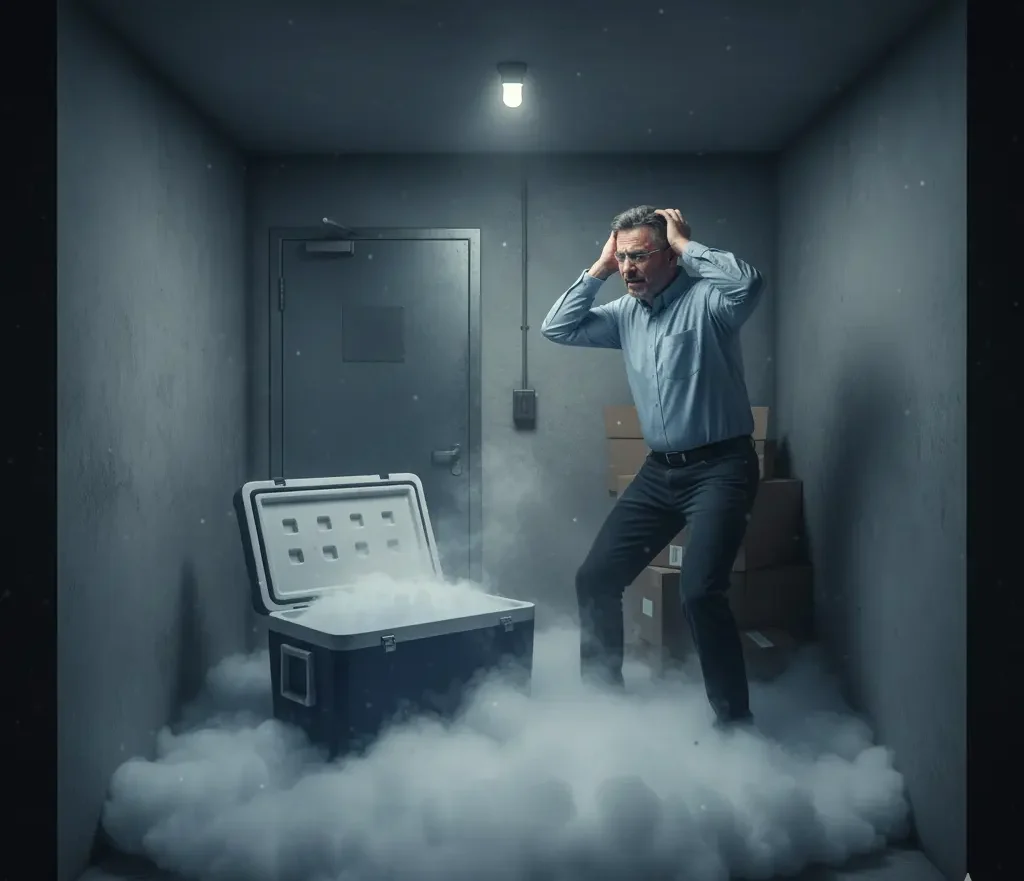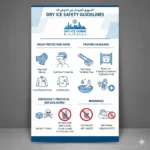Dry ice is a marvel of modern science, transforming ordinary events into extraordinary spectacles and preserving critical goods across industries. But beneath its magical fog and powerful cooling capabilities lies a fundamental safety question many ponder: Are dry ice fumes bad for you?
As the leading dry ice supplier in Dubai and across the UAE for over two decades, Dry Ice Dubai believes in not just providing premium quality dry ice but also empowering our customers with the knowledge to use it safely. Let’s demystify the “fumes” and understand how to ensure a secure experience every time.
What Exactly Are "Dry Ice Fumes"? It's All About CO₂
First, let’s clarify what “dry ice fumes” actually are. Dry ice is the solid form of carbon dioxide (CO₂). Unlike regular ice, it doesn’t melt into a liquid; instead, it undergoes a process called sublimation, directly turning into a gas.
So, the “fumes” you see wafting from dry ice are not smoke or a toxic chemical vapor, but rather visible clouds of extremely cold carbon dioxide gas mixing with and condensing water vapor from the ambient air. It’s essentially very dense, cold fog.
While CO₂ is naturally present in the air we breathe and is harmless in small concentrations, large amounts of it, particularly in poorly ventilated areas, can pose a significant health risk.
The Dangers of Carbon Dioxide (CO₂) Exposure
The primary danger of dry ice is not its “toxicity” in the traditional sense, but its ability to displace oxygen. Carbon dioxide is heavier than air. When dry ice sublimes, the CO₂ gas tends to settle in low-lying areas, pushing oxygen upwards.
If enough oxygen is displaced, especially in an enclosed space, it can lead to:
Oxygen Deprivation (Asphyxiation): This is the most serious risk. When oxygen levels drop, your body doesn’t get enough to function, leading to symptoms like:
- Rapid breathing and heart rate
- Dizziness, headaches, confusion
- Loss of coordination
- Nausea and vomiting
- In severe cases, loss of consciousness, convulsions, and even death.
Increased CO₂ Levels: High concentrations of CO₂ itself can also be harmful, affecting the respiratory system and blood pH.
Who is at Higher Risk? Anyone in a poorly ventilated, enclosed space with dry ice is at risk. This includes:
- Small rooms or storage areas
- Vehicles (cars, vans, cargo containers) during transport
- Basements or low-lying areas where CO₂ can accumulate
Essential Safety Practices: Handling Dry Ice Responsibly
To ensure that dry ice is a valuable tool and not a hazard, follow these crucial safety guidelines:
Prioritize Ventilation:
- Always use dry ice in a well-ventilated area. This is the single most important rule. Keep windows and doors open, or use exhaust fans.
- Never store or use dry ice in airtight containers or confined spaces.
- When transporting dry ice in a vehicle, ensure good airflow. Open windows slightly, or use a vehicle with an unsealed trunk/cargo area separate from the passenger compartment.
Proper Storage:
- Store dry ice in an insulated container (like a cooler), but never seal it completely. Allow for CO₂ gas to escape. A tightly sealed container can build up pressure and explode.
- Keep dry ice away from children and pets.
- Store it in a cool, dry place away from direct sunlight.
Personal Protective Equipment (PPE):
- Wear heavy-duty gloves (like insulated or cryogenic gloves) when handling dry ice. Its extreme cold (-78.5°C / -109.3°F) can cause severe frostbite similar to a burn.
- Consider eye protection (safety glasses or goggles) to prevent eye irritation from escaping CO₂ gas or accidental contact.
- Use tongs or a scoop, never bare hands.
Avoid Ingestion:
- Never put dry ice in your mouth or swallow it. It can cause severe internal injury (frostbite to internal organs).
- Be cautious when using dry ice for food or drinks, ensuring it fully sublimates before consumption.
Educate and Inform:
- If dry ice is being used in a public setting (like an event), ensure that attendees are aware of the safety precautions and potential risks.
- Label containers clearly.
When to Seek Medical Attention
If you or someone around you experiences any symptoms of CO₂ exposure (dizziness, headache, shortness of breath, confusion, nausea) while using dry ice:
- Immediately move to an area with fresh air.
- If symptoms persist or worsen, seek immediate medical attention.
- Do not attempt to rescue someone from a dry ice-affected area without proper ventilation and safety equipment, as you could also become a victim. Call emergency services.
Dry Ice Dubai's Commitment to Your Safety
At Dry Ice Dubai, we are committed to providing not only the highest quality, certified food and medical-grade dry ice but also ensuring its safe and responsible use. Our team of experts adheres to strict safety protocols for manufacturing, handling, and delivery of all our dry ice blocks, pellets, and slices. We are always ready to advise you on the best practices for your specific application.
Your safety is our priority. By understanding the nature of dry ice and following these simple precautions, you can harness its incredible power for cooling, preservation, and spectacular effects without risk.
Frequently Asked Questions (FAQs) About Dry Ice Fumes & Safety
What are dry ice "fumes" composed of?
Dry ice “fumes” are actually solid carbon dioxide (CO₂) sublimating directly into CO₂ gas. The visible white fog is not smoke but a cloud of water vapor condensed by the extremely cold CO₂ gas, which is mixing with ambient air.
Is it dangerous to breathe dry ice fumes?
Yes, it can be. While CO₂ itself isn’t toxic in small amounts, large concentrations, especially in poorly ventilated or enclosed spaces, can displace oxygen. Breathing air with insufficient oxygen can lead to symptoms like dizziness, headache, rapid breathing, and in severe cases, unconsciousness or even death due to asphyxiation.
How can I safely use dry ice to create fog effects for an event?
For fog effects, always ensure the area is very well-ventilated, ideally outdoors or in large open indoor spaces. Place the dry ice in hot water in a sturdy container. Keep children and pets away from the fog. Never allow the fog to accumulate in a confined area.
Can dry ice explode?
Dry ice doesn’t explode chemically, but it can cause an explosion if stored in a tightly sealed, airtight container. As dry ice sublimates, it turns into CO₂ gas. This gas needs to escape. If it can’t, pressure builds up inside the container, which can cause the container to rupture violently. Always store dry ice in a breathable, insulated container (like a cooler with a loose lid).
What should I do if I get dry ice on my skin?
Direct contact with dry ice can cause severe frostbite, similar to a burn. If this happens, immediately remove any clothing covering the affected area. Do NOT rub the skin. Seek medical attention promptly. In the meantime, you can warm the affected area gently with warm (not hot) water, but do not apply direct heat.
Is dry ice food-grade safe?
Dry ice itself is essentially pure CO₂, which is used in carbonated beverages. When produced to food-grade standards, it is safe for direct contact with food and beverages as long as it is handled properly and allowed to fully sublimate before consumption. Dry Ice Dubai supplies certified food-grade dry ice, ensuring the highest purity for your culinary and storage needs.
How much dry ice is considered "too much" for a confined space?
There isn’t a precise “one-size-fits-all” answer as it depends on the size of the space and the ventilation. However, as a general rule, any amount of dry ice can be hazardous in an unventilated, enclosed space. Always err on the side of caution: if you have dry ice, ensure constant fresh airflow. For large quantities, professional handling and monitoring are recommended.






